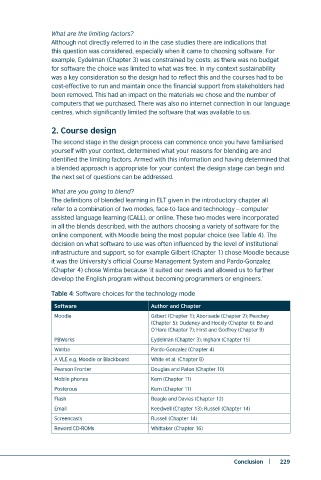Page 232 - BLENDED LEARNING
P. 232
What are the limiting factors?
Although not directly referred to in the case studies there are indications that
this question was considered, especially when it came to choosing software. For
example, Eydelman (Chapter 3) was constrained by costs; as there was no budget
for software the choice was limited to what was free. In my context sustainability
was a key consideration so the design had to reflect this and the courses had to be
cost-effective to run and maintain once the financial support from stakeholders had
been removed. This had an impact on the materials we chose and the number of
computers that we purchased. There was also no internet connection in our language
centres, which significantly limited the software that was available to us.
2. Course design
The second stage in the design process can commence once you have familiarised
yourself with your context, determined what your reasons for blending are and
identified the limiting factors. Armed with this information and having determined that
a blended approach is appropriate for your context the design stage can begin and
the next set of questions can be addressed.
What are you going to blend?
The definitions of blended learning in ELT given in the introductory chapter all
refer to a combination of two modes, face-to-face and technology – computer
assisted language learning (CALL), or online. These two modes were incorporated
in all the blends described, with the authors choosing a variety of software for the
online component, with Moodle being the most popular choice (see Table 4). The
decision on what software to use was often influenced by the level of institutional
infrastructure and support, so for example Gilbert (Chapter 1) chose Moodle because
it was the University’s official Course Management System and Pardo-Gonzalez
(Chapter 4) chose Wimba because ‘it suited our needs and allowed us to further
develop the English program without becoming programmers or engineers.’
Table 4: Software choices for the technology mode
Software Author and Chapter
Moodle Gilbert (Chapter 1); Aborisade (Chapter 2); Peachey
(Chapter 5); Dudeney and Hockly (Chapter 6); Bo and
O’Hare (Chapter 7); Hirst and Godfrey (Chapter 9)
PBWorks Eydelman (Chapter 3); Ingham (Chapter 15)
Wimba Pardo-Gonzalez (Chapter 4)
A VLE e.g. Moodle or Blackboard White et al. (Chapter 8)
Pearson Fronter Douglas and Paton (Chapter 10)
Mobile phones Kern (Chapter 11)
Posterous Kern (Chapter 11)
Flash Beagle and Davies (Chapter 12)
Email Keedwell (Chapter 13); Russell (Chapter 14)
Screencasts Russell (Chapter 14)
Reward CD-ROMs Whittaker (Chapter 16)
228 | Conclusion Conclusion | 229

